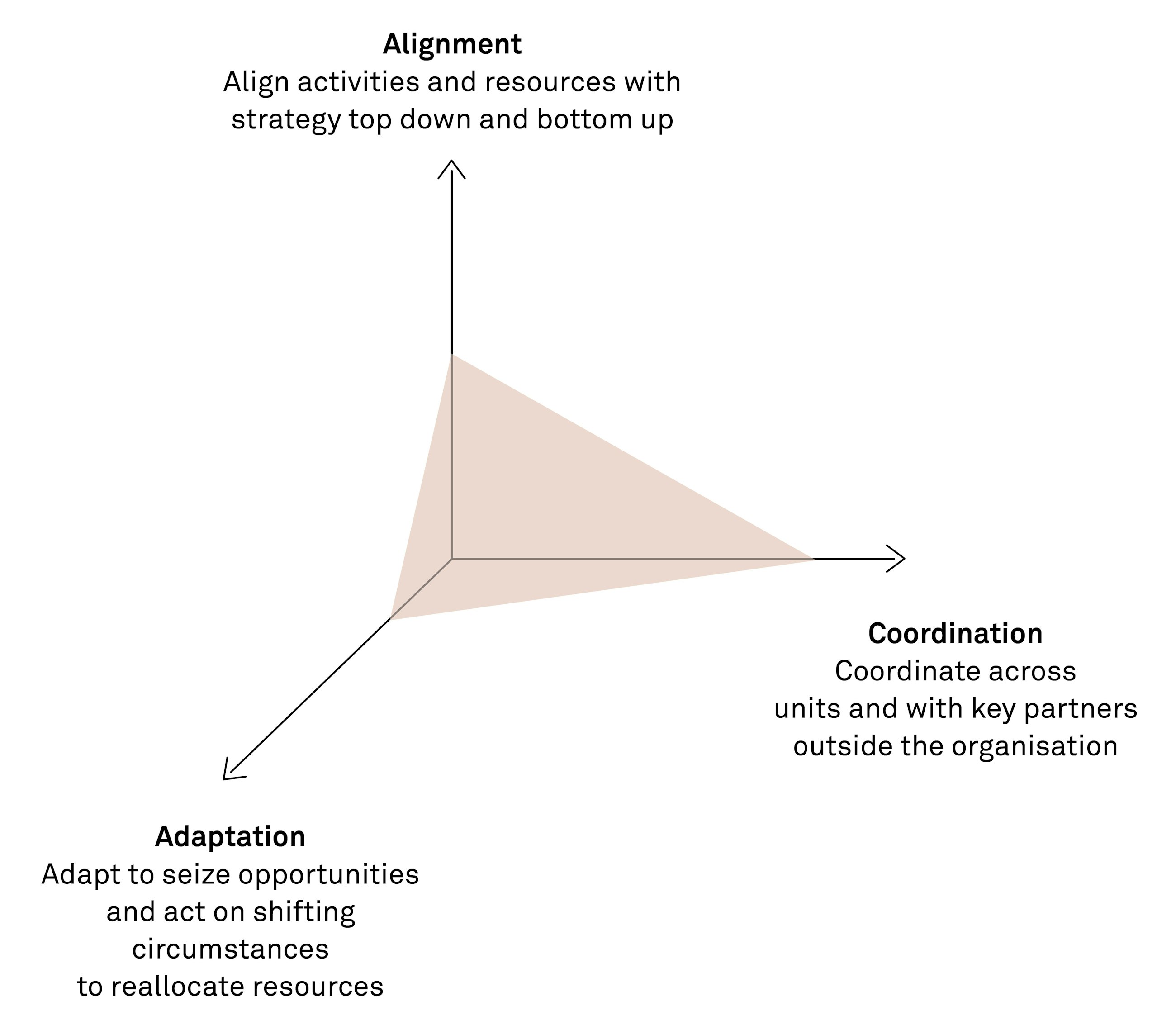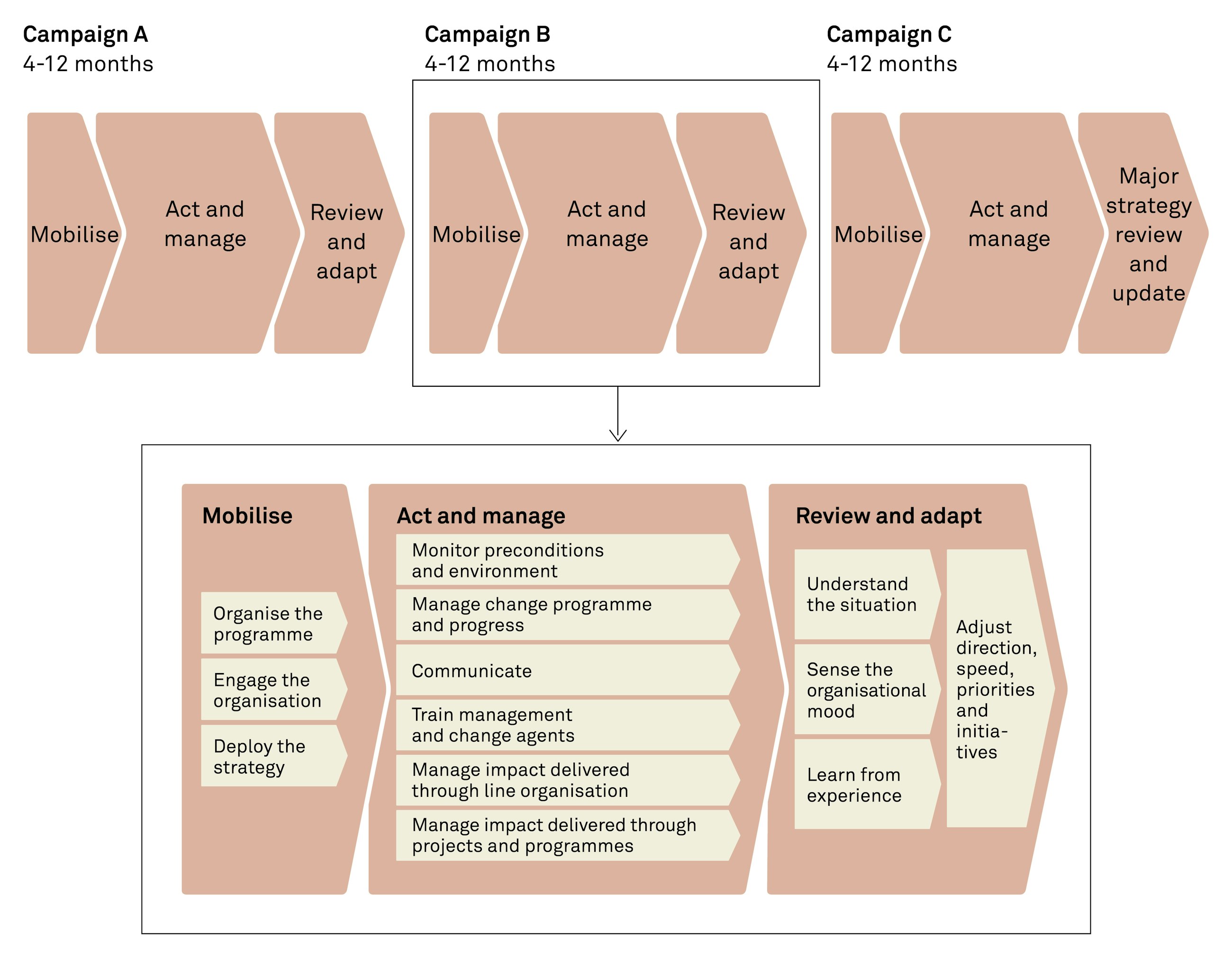Five principles for successful strategy implementation
15 March 2016
Making strategy work is one of the greatest challenges of management. In fact, no strategy is stronger than the weakest link in the chain between insightful strategic ideas to front-line actions. Based on Implement Consulting Group’s experience within strategic transformation, we have shaped five guiding principles that will help your organisation design a strategy implementation model to bridge the gap between strategy and impact.
In essence, strategy is about making choices – what to do and what not to do. It is actually that simple. But in reality, both the art of making the right strategic choices and the hard work of transforming the choices into real business impact are often unsuccessful endeavours. Research shows that more than 70% of strategies fail to achieve their desired objectives. The statistics are truly disappointing, and it seems like the issue is rather predictable. Why are we not capable of improving the quite unimpressive batting average? Why is it that we seem to be falling into the same execution traps over and over again? Obviously, the answer is not simple, and many underlying causes contribute to the difficulties of bringing strategy to life.
Pressure from outside stakeholders, unforeseen competitive threats and accelerating levels of global change make it difficult to navigate the process. Strategic initiatives are harder than ever to manage due to growing organisational complexity resulting in a lack of an overall picture of the situation. Managers fail to strike the balance between “running the business” and “changing the business” due to short-term performance demands and incentives. A low level of involvement in early phases of strategy results in a lack of broad ownership and, moreover, change processes are often managed on an ad hoc basis. Altogether, leaders find it difficult to “walk the talk” and make decisive resource allocations to drive the strategic agenda towards success.
The end result is too many initiatives, conflicting goals, an unaligned leadership team, disengaged employees, a lack of resources and too much reliance on simplistic performance management. These are just some of the symptoms that emerge during the life and death of a poorly managed strategy implementation.
However, if we take a look at the causes from a slightly different angle, it is evident that at the heart it is all about people. Strategies do not accomplish anything. Endeavours succeed or fail because of the people involved. People are motivated by sensing a meaningful purpose, feeling confident about how to succeed and being able to personally influence what they do. From this perspective, it seems logical that top-down-managed strategic changes prone with uncertainties are losing out to protect the status quo.
In order to bridge strategic intent with real business impact, we need to put the people and individual sense-making at the centre of implementing strategy. We need to rethink broken implementation models that put systems before people. We must acknowledge that the connecting thinking and doing is a far more demanding journey than spending a couple of days at a strategy off- site event. Therefore, organisations that want to make strategy work both in theory and practice need a truly human- centric strategy implementation model.
Defining the strategy implementation model
In order to excel at strategy implementation, organisations must put the right capabilities and management systems in place. Essentially, every organisation needs a strategy implementation model. When it comes to designing the model, one size does not fit all. However, five guiding principles based on experience and research serve as a strong starting point.
The five guiding principles play together in concert. At any given point in the journey, they will help consider implementation aspects of strategy work.
Principle #1 - Clarify strategy
Sharpen strategic choices, tell a compelling story, design a strategic choice-making cascade and articulate behavioural and business impact targets.
All too often, strategy work ends up in overwhelming presentations, myriads of strategic initiatives and resources spread thinly across priorities. In some situations, details are needed, but when it comes to making strategy work, a key practice is to be able to transform complex strategic problems into simple solutions. Not simplistic solutions – but simple solutions in terms of making the essentials stick.
Researchers have often debated the maximum amount of items we can store in our conscious mind, and the most conservative estimates set the limit at three or four. Likewise, strategy thinkers have developed the idea of defining a few must-win battles or setting a limited number of wildly important goals. To succeed in strategy implementation, we must resist the urge to fix everything at once. We need to create focus, reduce complexity and sharpen strategic choices based on an in-depth understanding of the key value drivers of the organisation. Cut the long tail of nice-to-have strategic initiatives. Do what really moves the organisation.
The ability to sharpen choices also enables the organisation to create a simple and effective strategy story. The strategy story should be able to cut through complexity to answer the fundamental strategy question: “Why are we doing it?”. Not only: “What should we do?” or “How should we do it?” A truly meaningful strategy story has the power to evoke positive feelings, create a shared context and paint a common picture of the future of the organisation.
On the one hand, the best strategies are based on distinct choices and can be communicated effectively to unify the organisation. On the other hand, the best strategies recognise the need for making choices at all levels of the organisation and making room for different substories that fit together in the overall picture. Corporate strategy makes choices about what businesses to be in, the business units define the competitive strategy for winning in the chosen playing field, functional units support the business units with the services needed to deliver on strategy, and external partners must align their way of working with new strategic directions. At the individual level, all employees must make their own choices about what to do – and what not to do.
Conceived in this way, the cascading process becomes a dialogue-based choice-making process in which different levels of the cascade are proactively involved in framing and making choices. Furthermore, the cascade from corporate level will be inspired by feedback flowing from the levels involved in more concrete operational choices. The point is that everyone in this system is involved in making choices – and no one is viewed as a passive recipient of strategy.
Does this approach require an effort in large organisations? Surely! But considering the negative side effects of traditionally managed topdown implementation of strategy, the advantages of cascading strategic choices are obvious. Consider this in the light of Harvard Business School Professor Robert Kaplan’s findings revealing that a mere 7% of employees fully understand their company’s business strategies, and what is expected of them.
Another core practice of clarifying strategy is to define measurable impact targets that will help the organisation keep track of the strategic transformation. This is hardly a surprise. But the devil is in the detail. The type and quality of impact targets are really important. In some cases, strategy targets are reduced to a set of longterm financial ambition levels. In our experience, the most effective targets are quite the opposite. They are concerned with decomposing longterm ambitions into really tangible targets that combine both leading and lagging indicators of progress.
More importantly, we need to dig deeper than business performance measures in order to reveal the real drivers of change. As mentioned, strategies do not accomplish anything. People do. Therefore, the key is to engage the organisation in defining the behavioural changes required by the new strategy. Observable behavioural change is one of the best indicators of strategy implementation done right. And if no behavioural change can be observed during implementation, corrective actions must be taken promptly.
Clarifying strategy at Coloplast
The global medtech leader Coloplast makes life easier for people within diverse areas such as ostomy, urology and continence care. Over the last six years, the management has successfully turned around the company and delivered strong results. To support the strategic transformation, one of the key tools leveraged has been the so-called Agenda. While corporate strategy lays out the long-term plan, and business area strategies define the market actions, the Agenda is a strong vehicle for communicating the top 10 priorities in the organisation. The Agenda is short and sharp; it is about what happens right now and first and foremost about the priorities that all employees must be able to refer their strategic work to. The Agenda is updated yearly and launched broadly supported by frequent status updates.
Tips for clarifying strategy
- Clarify major strategic choices and craft a few must-win battles to focus efforts on the key value drivers
- Design an ambitious, but realistic transformation map to navigate the strategic transformation
- Tell a compelling and meaningful strategy story to create a shared context across the organisation
- Create a strategic choice-making cascade to empower and engage employees at all levels of the organisation to make distinct choices
- Strive for early symbolic wins to build momentum by putting theory into action
- Define behavioural and business impact targets for strategic initiatives to monitor progress towards goals
Principle #2 - Unify leaders
Build unity in the leadership team, establish clear accountability and define non-negotiable leadership behaviours.
Often, strategy turns into a simple two-step process. Firstly, let us fix the problem and get the strategy straight. Secondly, tell the organisation what to do and execute. Described in this simplistic manner, it is almost selfevident what is wrong. Making strategy is separated from executing strategy. The creative and analytical process of solving problems is separated from the social and emotional process of making sense of a new direction. In the twostep process, we end up facing severe challenges in terms of “selling” the strategy. We must put all efforts into persuasive power talks and beg that the extended leadership team, middle management and employees are getting motivated and “bought in.”
Consider the iconic “burning platform memo” written by former Nokia CEO Steven Elop. In the memo, Elop desperately tries to engage all employees in, metaphorically speaking, jumping from a burning oil platform into freezing waters. By adhering to conventional wisdom, we unintentionally activate all human social domains that control actions to release a whirlwind of negative feelings and resistance among large groups in the organisation. They were not important enough to be listened to. They felt quite uncertain about what to do as they were only told a short roadshow version of the strategy, and any sense of personal control over events in their lives was steamrolled. They just had to stick to the plan. Please jump into freezing waters!
To resolve the quite obvious issues, it is essential to discard the traditional twostep model. We have to work under the assumption that agreement about strategic choices needs to be rooted deeply in the extended management team. Empowering leaders to challenge each other and aligning views about the desired direction is one of the strongest tools for creating leadership unity and making strategy work. Implementation starts from day one in the strategy process and is founded on creating an atmosphere of mutual trust in the leadership team.
In the course of the strategy process, the hard operational work of implementation will gradually play a more significant role. At this point, it is vital to make strategy stick on top of the management agenda. Best practice includes making sure that accountability for implementation is anchored at the very top. Sponsorship of key strategic initiatives should be agreed by the top management to ensure organisational traction, sufficient resources and efficient removal of obstacles. Furthermore, the leadership team should agree on role modelling behaviours and a mutual commitment to “walking the talk”. The phrase “show, don’t tell” still holds true. A recent survey found that 86% of senior leaders believed that they incarnated the new strategy. However, only 53% of direct observers believed that senior leaders embodied the change. Walking the talk is hard in practice.
While all of the above practices are key to creating a unified leadership team aligned on persistently implementing strategy, there is also a more delicate side to creating leadership unity. In some cases, leaders simply are not up to the job, and the only way out is to make adjustments to the team composition.
In other cases, the leaders do not have the required capabilities for managing change and strategic initiatives. Change of strategic direction inevitably requires big organisational changes, and obviously all leaders responsible for delivering on strategy need to understand the dynamics of successful changes to cope with actions and reactions across the organisation. How do I handle resistance and involve stakeholders appropriately? How do I manage large-scale strategic initiatives in a sponsor or initiative owner role? How do I align horizontally and vertically to ensure firmness and flexibility of direction? These and similar questions are not unique and tend to pop up during most strategy implementations. Therefore, strategy leaders should build on the vast body of knowledge within managing changes to avoid classic traps and accelerate realising the benefits of great strategies.
Principle #3 - Build engagement
Mobilise stakeholders through co-creation and communication, enable sensemaking at the individual level and build capabilities for new ways of working.
The best strategies communicate on many different levels ranging from the vivid and crisp strategy story that instantly makes sense to precise underlying reasoning and detailed road maps that support implementation. When to use what communication vehicle should be detailed in a systematic engagement plan that segments key stakeholder groups and defines appropriate communication actions using the full palette of communication channels and media. In the process of making the plan, it is vital to think about not only traditional oneto- many communication vehicles, but also to stage strategy conversations at large-scale events, embed peer-to-peer strategy dialogues in daily routines and apply strategy games stimulating thinking about making good strategic choices in different situations. The aim of the broad-based communication efforts is to build importance and understanding of the strategy across the organisation.
At the individual level, it is key to recognise the role of the leader. According to recent research by Gallup, less than one third of Americans are engaged in their jobs. In fact, the surprisingly low number of employees who declare themselves involved in and enthusiastic about their work has remained consistent for more than 15 years. Looking closer at the numbers, leadership practices account for at least 70% of the difference in employee engagement scores.
Highly engaged leaders, who frequently talk with employees about their responsibilities as well as help set work priorities and performance goals, are more likely to build engagement. Moreover, leaders who are approachable, focused on nurturing employee strengths and engaged in frequent face-to-face conversations have a strong positive impact on engagement levels. Conversations should not be about the manager telling the employee what to do. Rather, conversations should be about the manager helping the employee make his/her own choices and define priorities building on the strengths of the employee.
Supporting evidence for this approach can be found in scientific research of the drivers of motivation. Firstly, establishing an inner sense of importance is supported when allowing the employee to make sense of the strategy from his or her own perspective. Why is it meaningful to me? What choices must I make to support the strategy? Secondly, building on strengths is a superior approach to pointing out weaknesses as the inner feeling of confidence grows when the employee feels competent and capable. How can I contribute? How might I leverage my competences? Put together, raising the inner feelings of importance and confidence builds motivation and engagement. Therefore, the job of the leader is first and foremost to be a facilitator of individual sense-making – and not to be a heroic visionary who enthusiastically tells about what to do and what not to do.
Obviously, change of strategic direction sometimes calls for building entirely new capabilities. In those situations, evoking a feeling of confidence is enabled by well-crafted capabilitybuilding programmes. But ultimately, implementing strategy and building broad-based engagement must happen through sense-making and choice-making processes at the individual level. Extrinsic motivators such as compensation, rewards, recognition and fear of failure may drive engagement to some degree. But as multiple sources of research tell us, there is abundant evidence that strategy will only come to life when employees and leaders alike are deeply engaged and motivated, because they find the strategic journey involving, exciting, important and personally challenging.
Tips for building engagement
- Involve employees as early as possible to co-create solutions to exploit the collective intelligence of the organisation
- Create a stakeholder engagement plan detailing target groups, key messages and communication vehicles to build broad-based understanding
- Empower leaders to have sensemaking conversations with employees to create importance at the individual level
- Provide training and learning experience to build new skills and capabilities for new ways of working – among leaders and employees alike
- Communicate in an authentic and appreciative way to make room for individual interpretations and stories
Principle #4 - Align commitments
Allocate capital, time and people, install management system for coordinating and adapting strategy and support major strategic initiatives through portfolio management.
In essence, successfully implementing strategy is about aligning commitments. Commitments come in many shapes and forms. Clarifying and cascading strategic choices, unifying the leadership team and building broad-based engagement can all be viewed as steps towards mutual alignment of commitments. However, the crucial sense-making processes taking place among leaders and employees must be supported by well-crafted management systems to underpin strategy implementation.
Firstly, management systems need to support aligning and coordinating vertically, but more importantly, they must enhance collaboration horizontally across units and with outside partners. The latter proves to be one of the more difficult aspects of implementation. Studies show that 84% of managers report that they can rely on their boss and direct reports all or most of the time. Only 9% of managers say that they can rely on colleagues in other functions and units all of the time. That is why management systems must be designed carefully to help horizontal coordination.
Secondly, the management systems must ensure ongoing adaptation of strategy due to shifting circumstances or emerging opportunities. Whereas much strategy development is done according to a formal yearly process, the world does not seem to move mechanically according to the linear organisational clockwork. Strategy needs to balance a sense of firmness with openness to change at all times, requiring ongoing attention from the senior management. Another key task that should be formally embedded in management systems is follow-up on key performance indicators, tracking of value creation and capturing of insights and learning that can be shared across the organisation.
The exact design of management systems needs to be customised to the organisational context, but classic systems include processes for tracking key performance indicators, establishing the right incentive systems, managing the portfolio of strategic initiatives and enabling coordination through a cross-organisational meeting structure and supporting progress through a central strategy implementation office.
If management systems represent the plumbing and piping of strategy implementation, the ability to decisively allocate resources releases the vibrant flow of energy through the systems. While the metaphor seems simple, making resource allocation work in practice is one of the most important tasks of management. The proactive management of scarce resources in the organisation is almost always severely challenged by commitments made in the past and short-term operational demands. Only 30% of managers declare that their organisation effectively shifts funds across units. Habitually, standards of good judgement are put aside due to an inherent bias towards the status quo. Therefore, management systems must be designed to drive the right resource allocation discussions and decisions at all management levels.
Resource allocation needs to be understood broadly and includes allocation of capital, assets, talent and time. Capital must be made available, including allocation between business units and functions as well as capital for major investments or spending adjustments for functional areas. Scarce resources such as equipment and other assets must also be considered to ensure full alignment with strategic priorities. Hiring and firing due to changes in strategy must be executed as well as allocating people with the right competences and mindset to the prioritised strategic initiatives. Last but not least, realistic time estimates must serve as the basis for the allocation of resources. Otherwise, short-term obligations and performance goals tend to override the long-term initiatives. The best management systems effectively deal with both the bias towards status quo and short-term thinking.
Tips for aligning commitments
- Establish strong processes for resource allocation (capital, assets, time and people) across organisational units and within the portfolio of strategic initiatives
- Design governance and meeting structures to drive changes, ongoing alignment, coordination and adaptation of strategy
- Align organisational design, including roles and responsibilities, performance measures and supporting incentives with strategy
- Establish and reinforce simple rules and value-based initiatives to align corporate beliefs and symbols with strategy
- Embed strategy in employee development conversations and performance goals to align employee goals with strategy
- Map critical assumptions to be monitored so that strategy can be adjusted if assumptions do not hold true.
Principle #5 - Accelerate value delivery
Build project and line management delivery capabilities, implement strategies through high-impact projects and empower line managers to take the lead.
As a rule of thumb, most strategic changes require some sort of design and development work before the changes can be anchored in the line organisation. The development work is a temporary endeavour undertaken to mature the strategic ideas and should therefore be managed formally as projects to accelerate value delivery. It sounds easy in theory. But consider the fact that 51% of global organisations are at maturity levels 1 and 2 when it comes to programme and project management. Projects are basically managed on an ad hoc basis with a lack of structured processes.
Most organisations simply do not have the right capabilities in place to realise the benefits anticipated by the strategy. Perhaps the strategic choices were brilliant, but we will basically never know, because the vehicle for accelerating value delivery is broken. The key is that you simply cannot separate strategy and implementation. The pieces must fit together, and strategic choices made and validated in theory must be closely aligned with what is possible to accomplish by the organisation in practice.
If no high performance setup for project management is in place, chances are that all good intentions end up in a clutter of mismanaged projects.
Consequently, project management capabilities must be built in the organisation to ensure a consistent approach to value delivery. Projects must be staffed with strong teams led by experienced and respected project managers who are put in charge of driving large-scale strategic initiatives according to best practice standards.
Once again, the devil is in the detail. Be careful that “best practice” truly is best practice. In terms of project management, best practice means being able to select the appropriate development model to fit with the challenge ranging from classic waterfall planning to modern agile approaches as well as mastering tools like prototyping, user insights building and a range of change management techniques. It sounds easy just to launch a range of projects to accelerate value delivery. In practice, it is hard, and it takes a lot of talent to succeed in heavy change projects.
As described, most changes devised by strategy need to be accelerated through some sort of project-based delivery vehicle. In some cases, the changes can be swiftly handed over to the line-of-business organisation by adjusting for instance performance measures and helping employees set new work priorities. However, in general, the transition from a temporary strategic project to new ways of working in the line-of-business organisation is difficult and must also be carefully managed.
It often entails that operational management practices must be reviewed and potentially upgraded as well. Are managers adjusting departmental goals and individual performance dialogues according to the strategy? Do managers leverage Lean management principles to continuously optimise value streams? Are employees frequently gathered to evaluate progress on the road towards strategic goals? These and similar questions are also integral to the art of making strategy work. In this way, constantly seeking out new ways of accelerating value delivery should be high on the agenda in both projects and daily operations.
Accelerating value delivery at Nordea
A new strategy inevitably equals change. At the largest financial services group in the Nordics, Nordea, change is a constant. New regulations, changing customer needs and perpetual technology disruptions are transforming the industry. In order to stay at the top of the game, Nordea must master the art of managing a large set of strategic changes. In the Savings & Wealth Offerings department, more than 100 strategic initiatives have been defined and are driven as projects ranging from small-scale changes to large-scale transformations requiring big resource commitments and horizontal collaboration between functional units.
Larger projects are monitored and supported on a monthly basis to make sure that the desired benefits are being realised. The overarching portfolio setup is key to aligning commitments and accelerating the projects with the largest impact. At the project level, each project runs through a four-phase model that serves as a structured and unifying approach to getting from the initial strategic choice to actual value creation. All projects have clearly defined objectives linked to the strategy and dedicated resources to make sure that objectives can be reached. At the closure of each project, results and capabilities are anchored in daily operations.
Tips for accelerating value delivery
- Define the right project model for managing strategic initiatives to reduce risk and drive progress
- Build project management and change leadership capabilities among project managers who are in charge of strategic initiatives
- Staff major strategic initiatives with the right team and always strive for high-intensity resource allocation to create focus
- Implement strategic initiatives in time-boxed campaigns for fast results and ensure flexibility to navigate
- Track leading indicators on business and behavioural impact for all strategic initiatives
- Drive line organisation engagement and changes through applying the principles of Lean operations management to ensure continuous improvement
Putting the pieces together
On the one hand, it might seem as an overwhelming task to design the right strategy implementation model and put the capabilities and management systems in place. The five guiding principles and the supporting evidence tell us that there is no such thing as a strategy implementation silver bullet. Just lots of good and hard work. On the other hand, many of the core ideas underlying the principles are actually common sense and based on well-known management practices. The key is to consider the interdependencies across the elements and to design an integrated approach to implementation. Last but not least, we must always remember to put the people at the centre of making and implementing strategy. If we do, chances are that we will not end up like the large majority of organisations that are not able to deliver on strategic ambitions.









